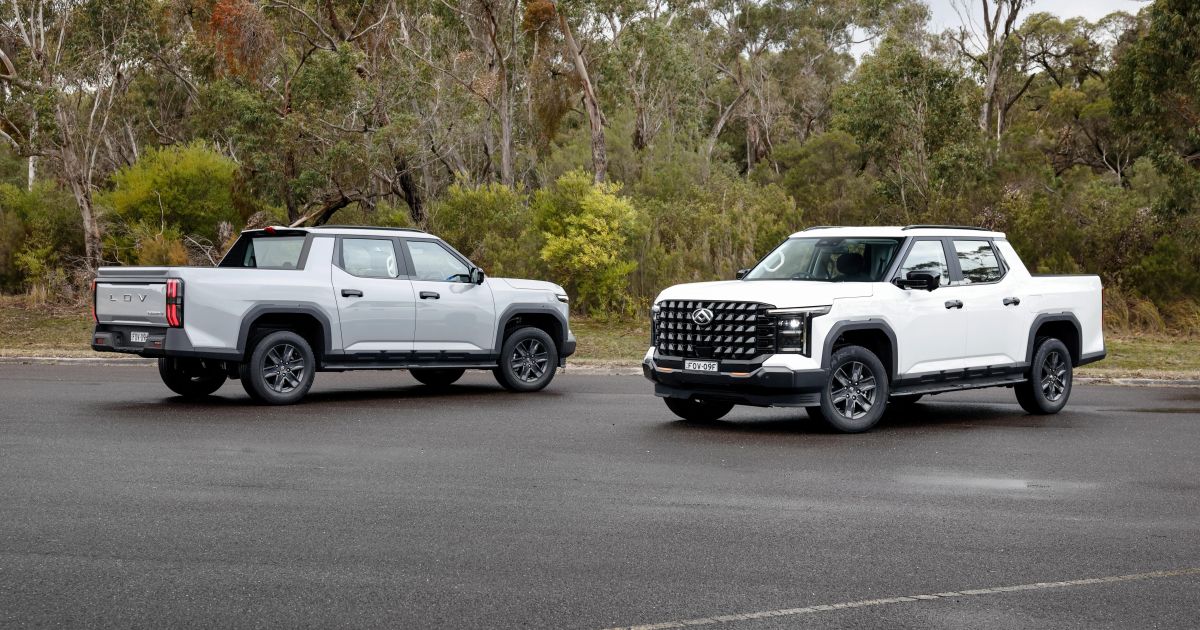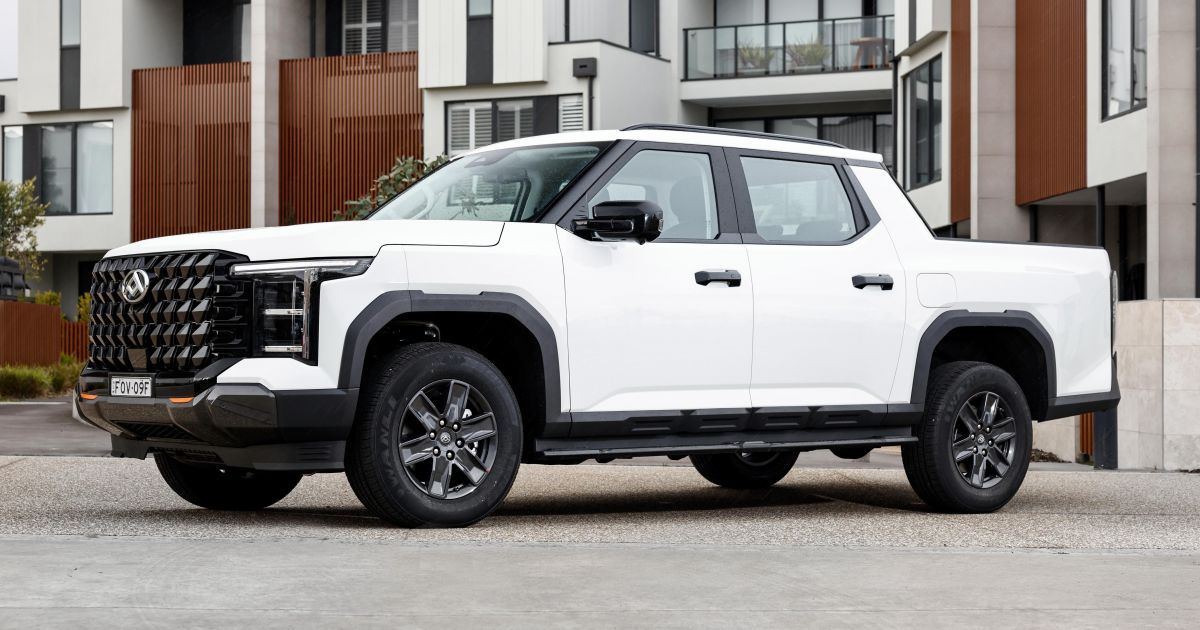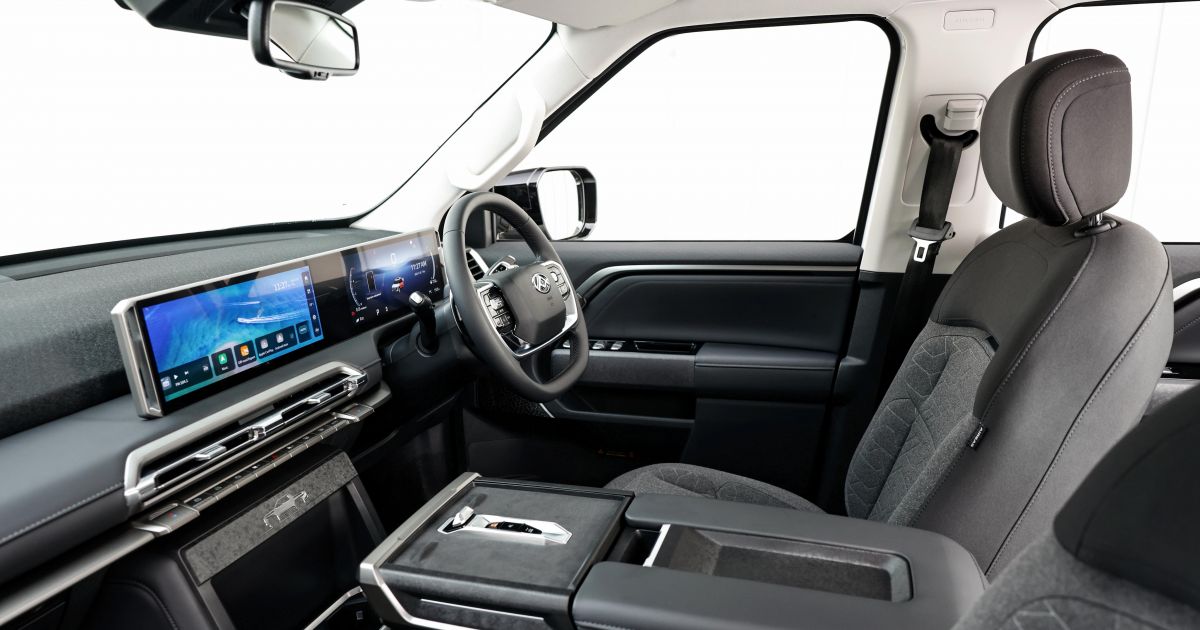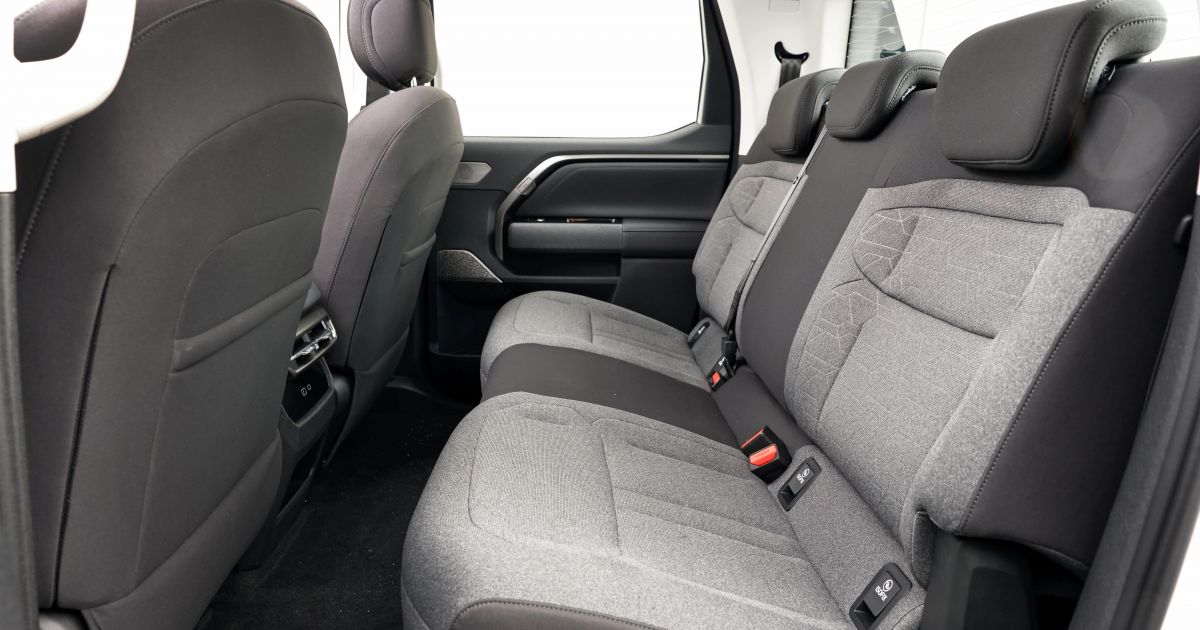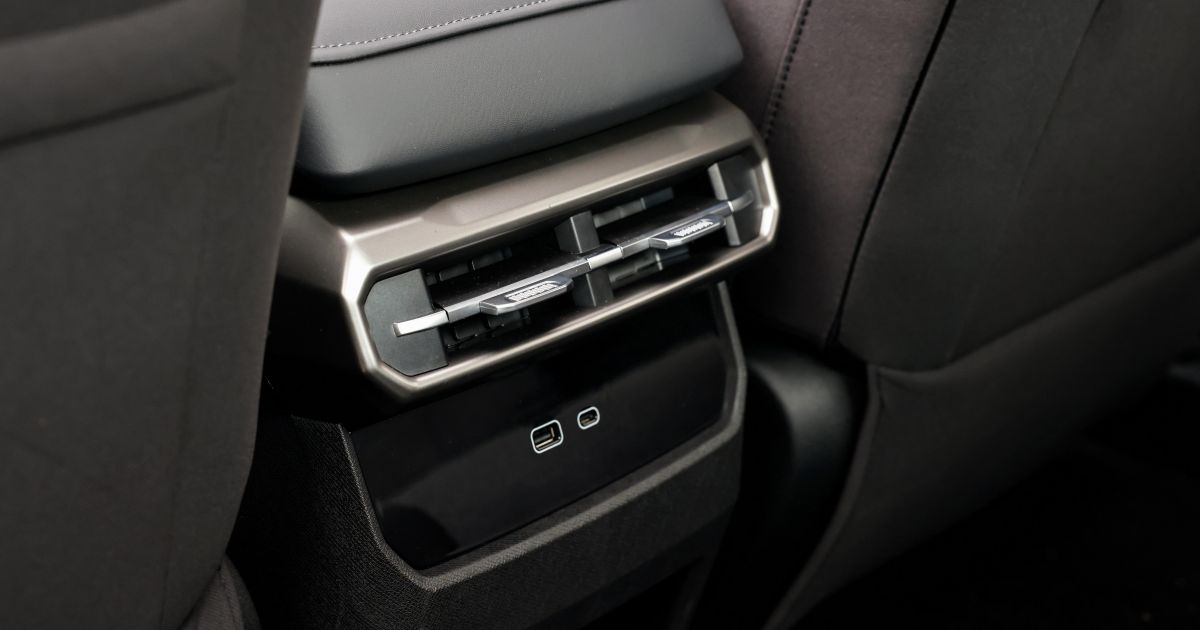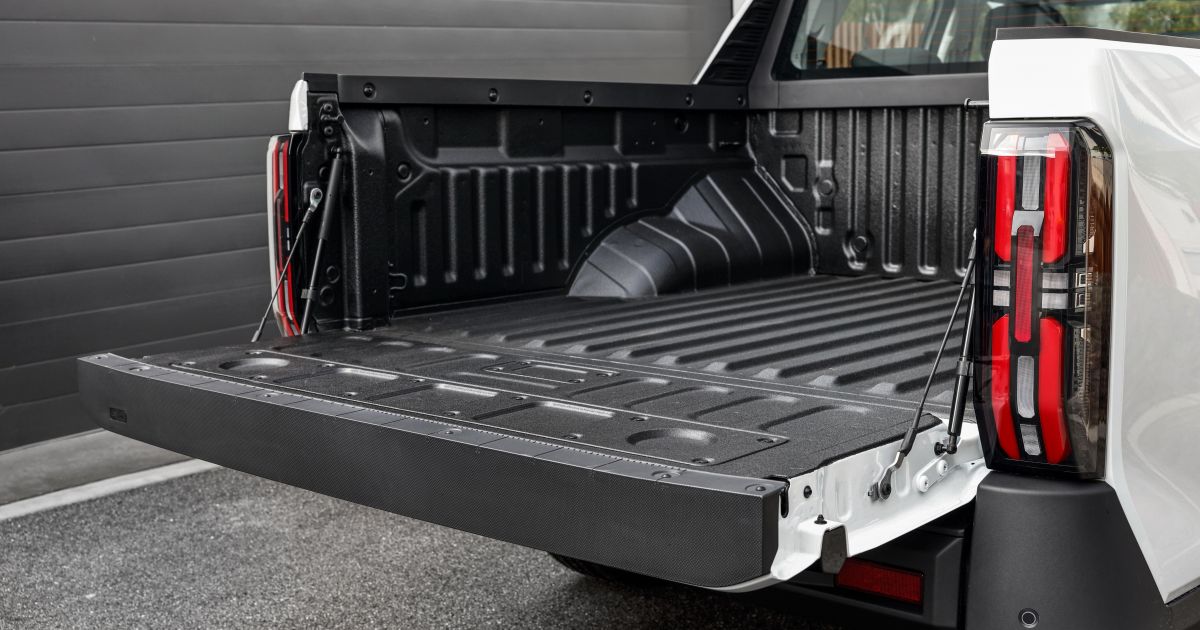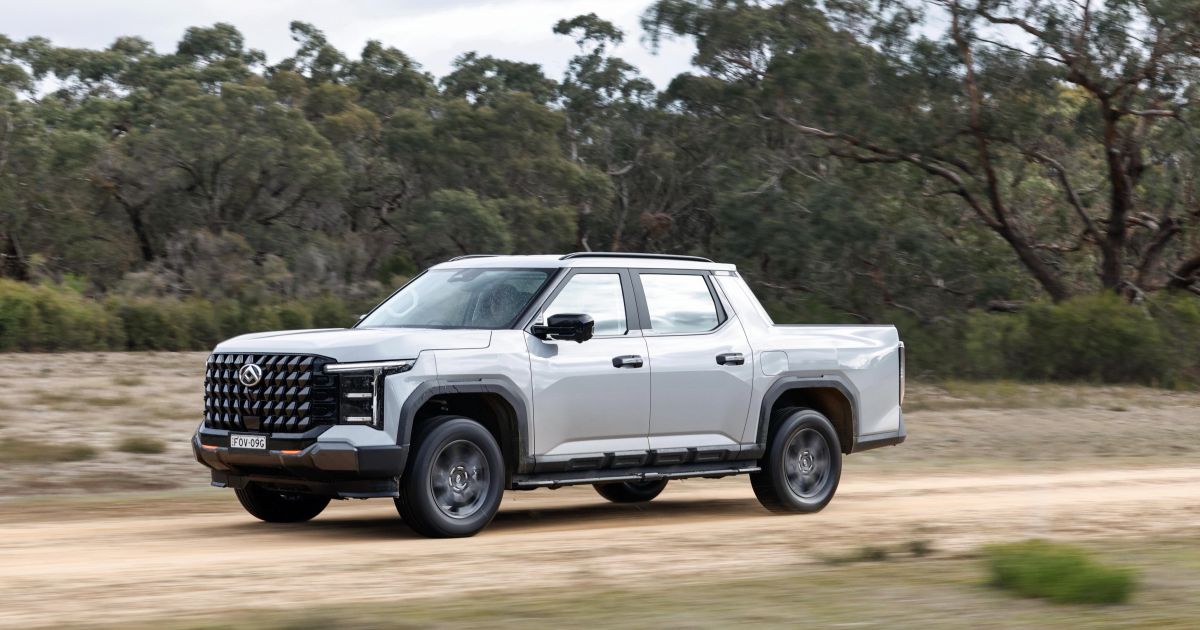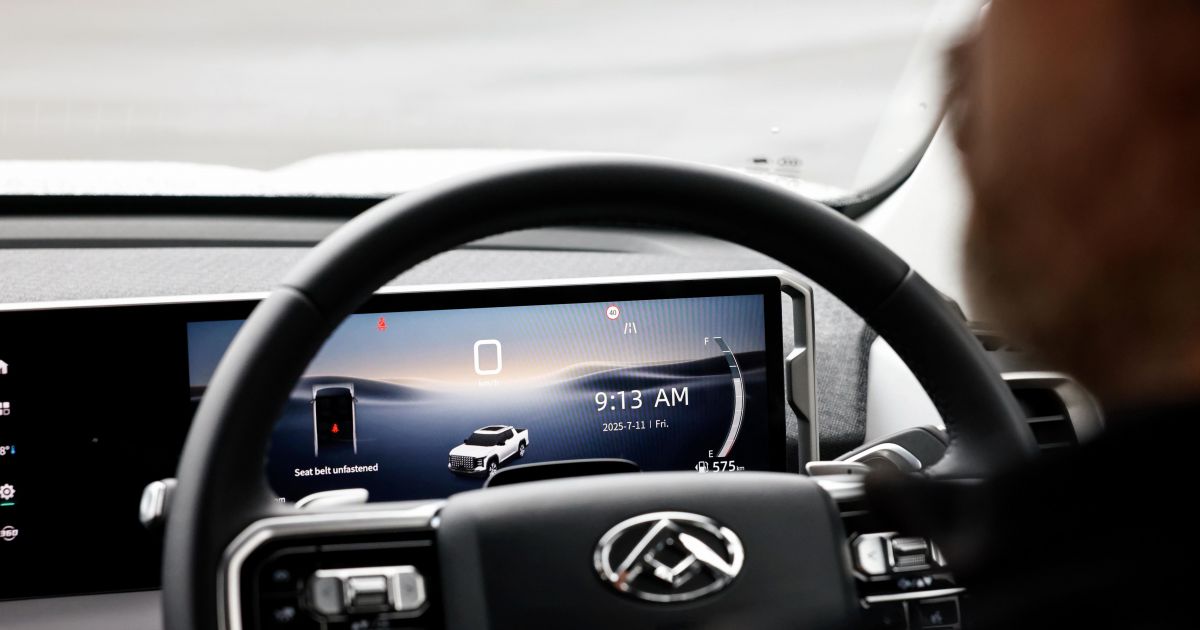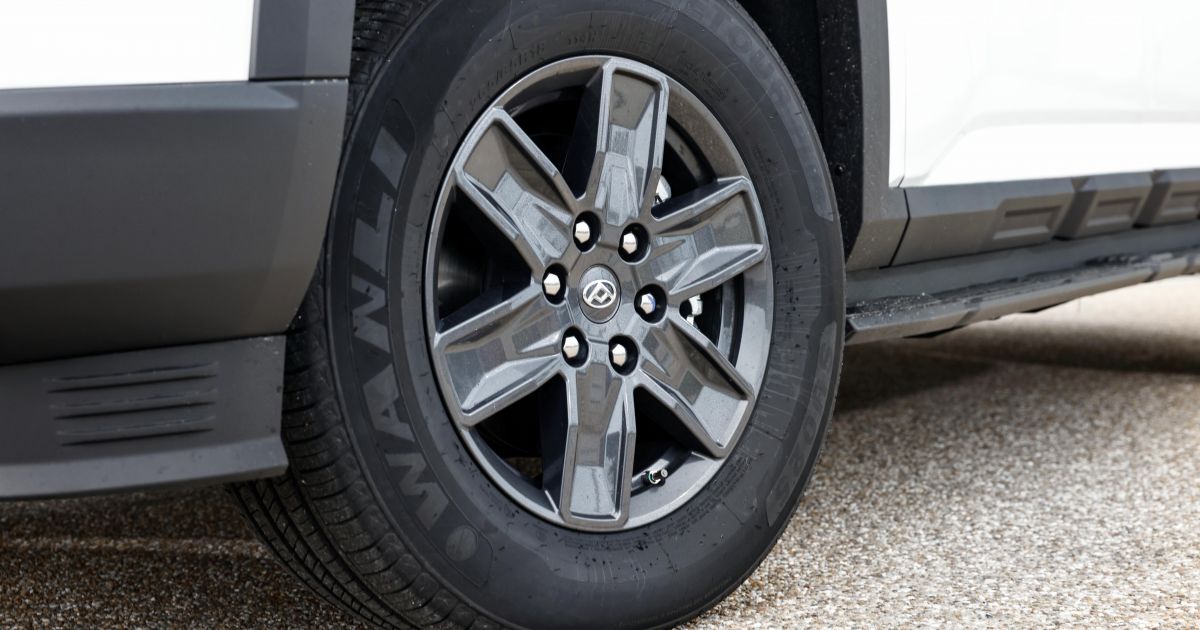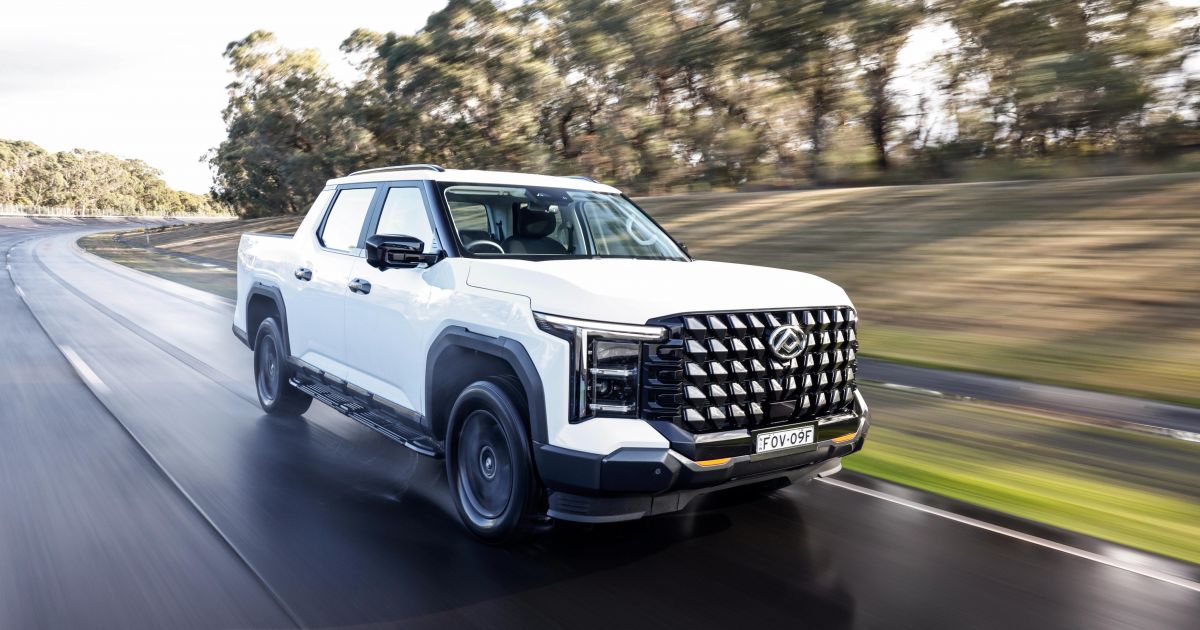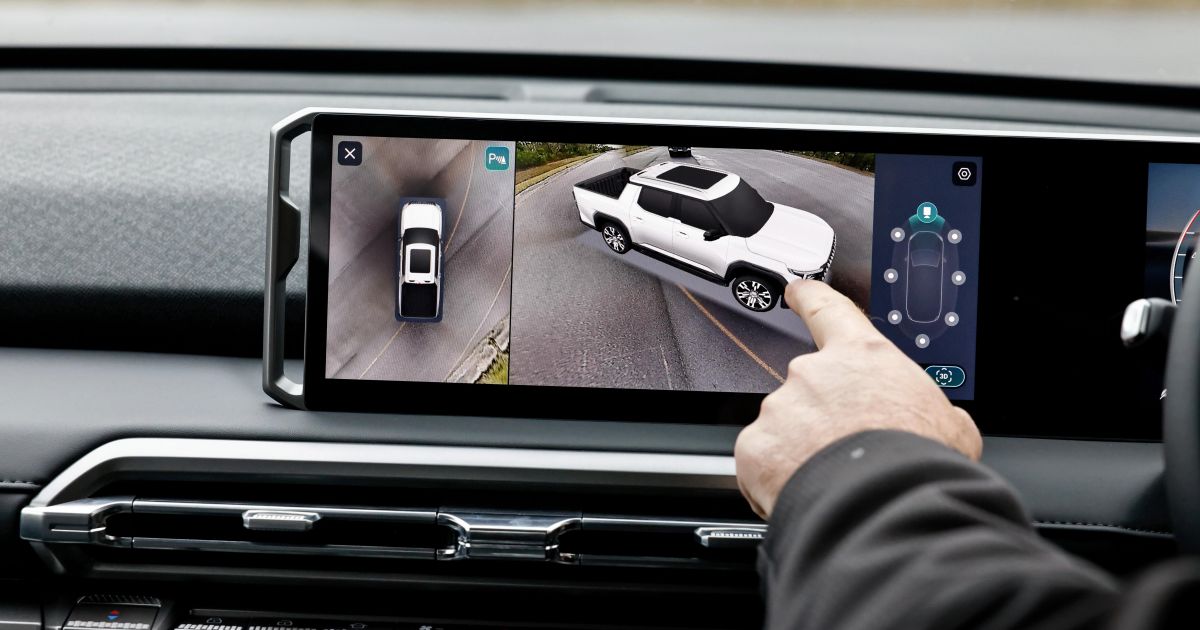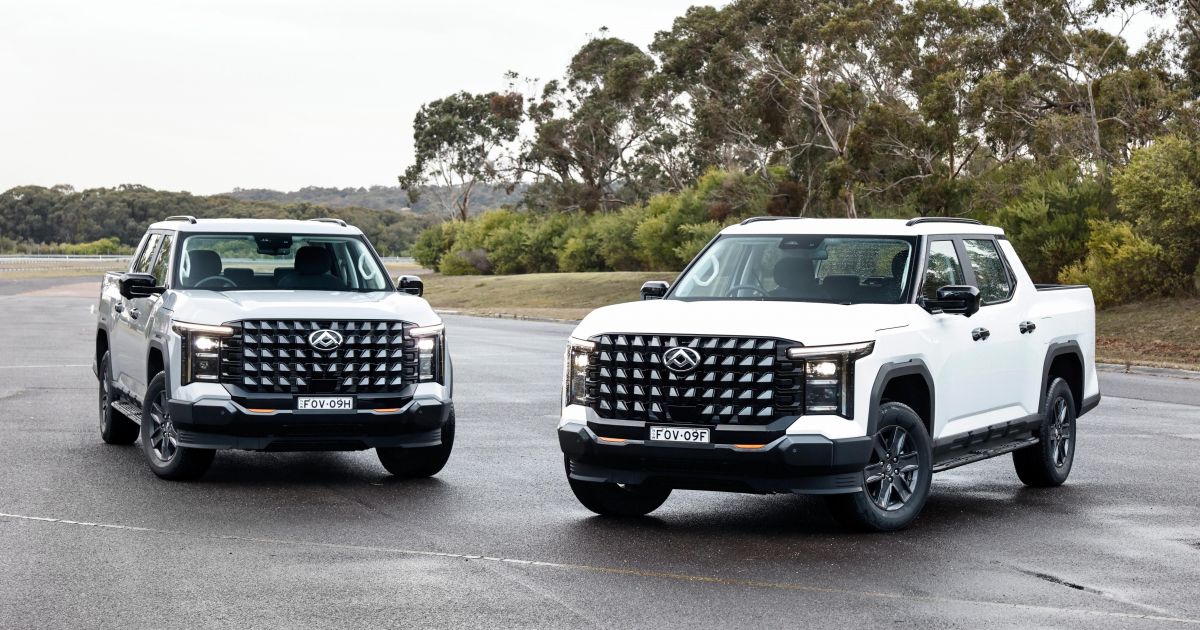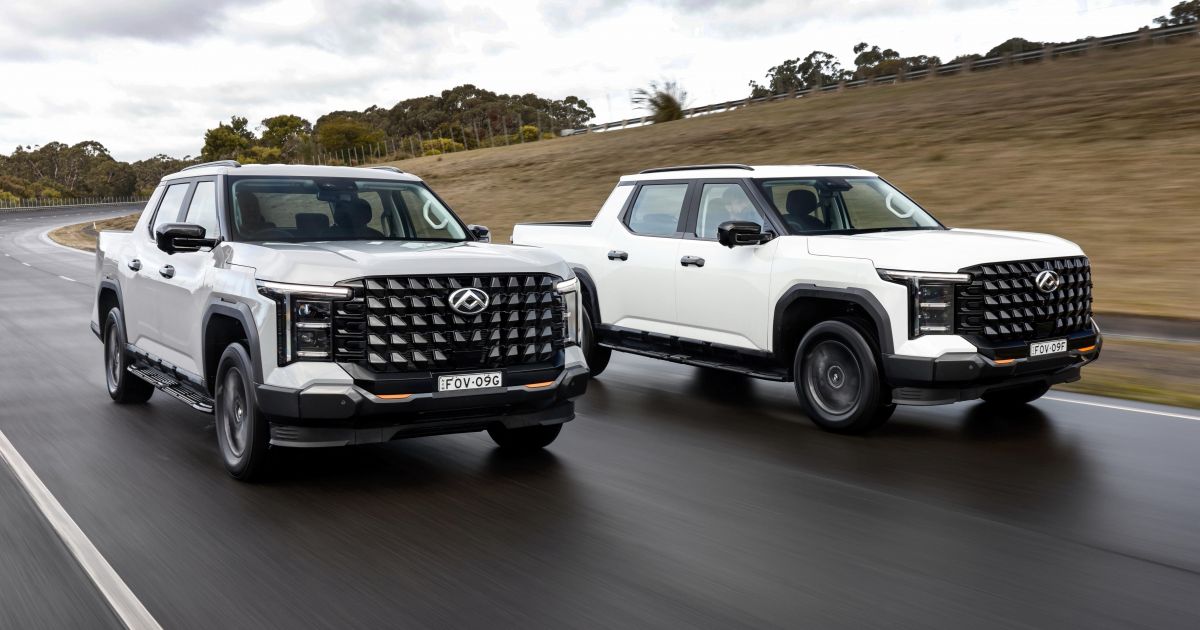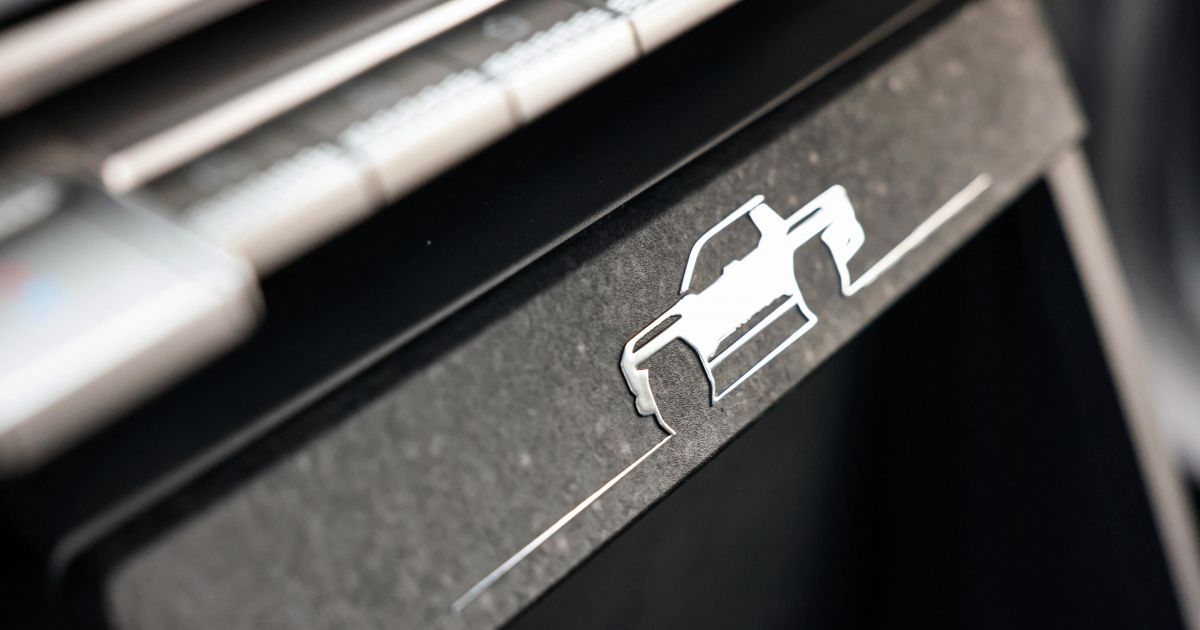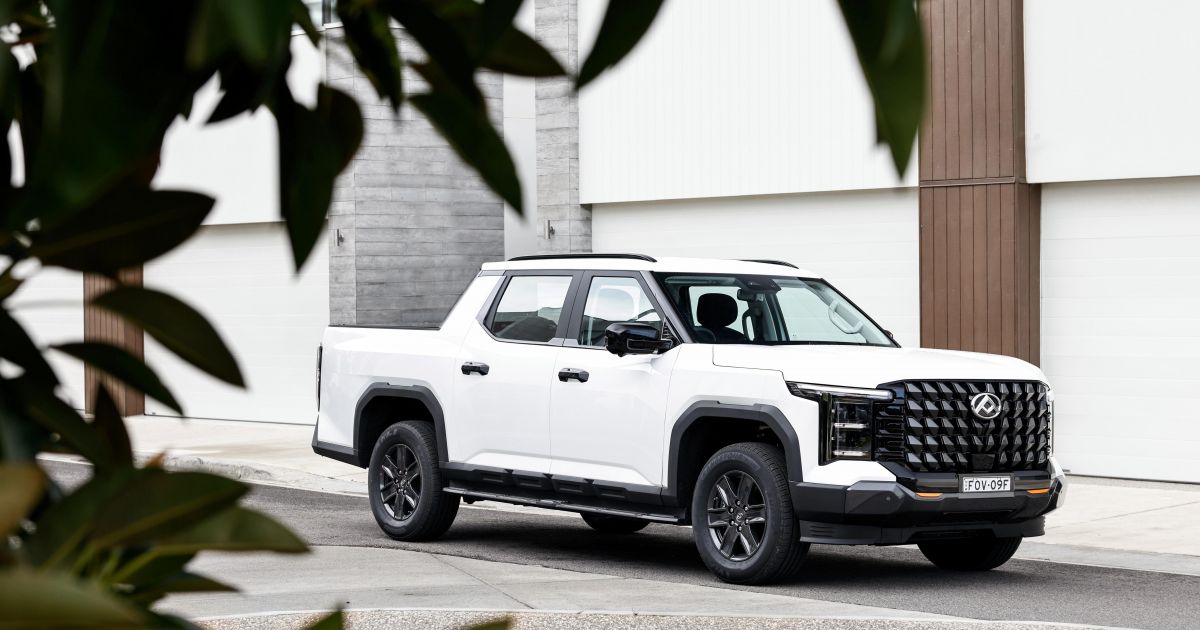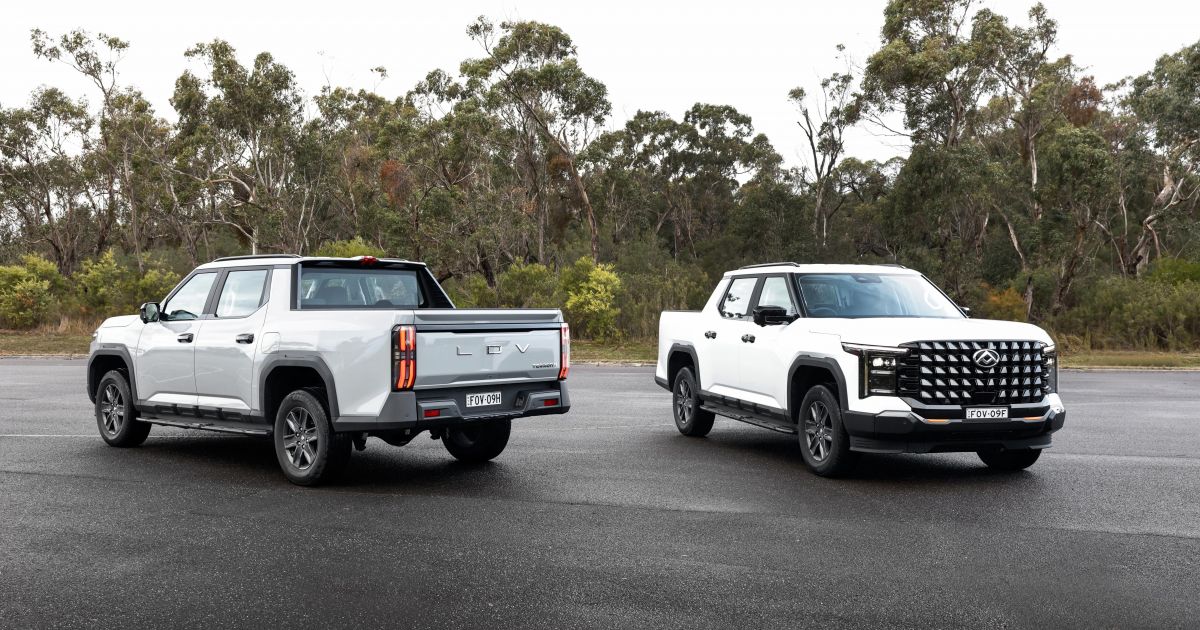The first ever LDV Terron 9 dual-cab 4×4 ute is bigger than a Ford Ranger, cheaper than a Toyota HiLux and will spawn a near-identical twin in the upcoming MG U9 – so should you wait for the MG or go for the Terron 9, which is now in showrooms?
Search for the meaning of ‘Terron’ and you’ll find it’s “a block of sun-dried sod used as a construction brick” according to Texas folklore, or a ‘clod’ or ‘lump’ in Spanish. It’s also a boy’s name for “the earthy kid with their feet firmly planted on the ground”.
This makes sense for a completely new dual-cab ute from LDV, which is a potential building block for a bigger range and more customers in Australia’s booming ute market.
It’s positioned above the existing T60 dual-cab in the LDV lineup in terms of both size and price, bringing a larger, more sophisticated option to the Chinese brand’s local showrooms, with value-for-money pricing starting at $50,990 drive-away for ABN=holding buyers of the entry-level Origin variant tested here.
Being bigger than the T60 means the Terron 9 is also larger than the top-selling Ranger/HiLux cohort – but not as big as the Ford F-150, Toyota Tundra, Ram 1500 or Chevrolet Silverado 1500. The Terron 9s’ closest-sized competitor is the GWM Cannon Alpha, which starts at $52,990 drive-away.
For just over $50k on the road, the Terron 9 comes with the obligatory 3500kg towing capacity as well as a spacious five-seat cabin, full-time four-wheel drive and one of the most powerful turbo-diesel engines in its class.
LDV claims the Terron 9 doesn’t drive like a truck, despite offering benchmark towing capability and boasting an 1100kg payload – so let’s see if the claim is true and if its feet are indeed “firmly planted on the ground”.
How much does the LDV Terron 9 cost?
The Terron 9 is available in two model grades: the entry-level Origin we’re testing here, and the mechanically identical Evolve flagship.
Introductory pricing for ABN holders takes $1000 off the prices listed below, meaning that for business buyers the Origin will initially cost $49,990 drive-away (nationally) and the Evolve will cost $54,990 drive-away.
The GWM Cannon Alpha is its closest rival in terms of size and price, with equivalent diesel 4×4 versions starting at $52,990 drive-away. The MG U9, due in Australia later this year, is essentially the same vehicle as the Terron 9 (LDV and MG are both part of Chinese auto giant SAIC), but MG Motor Australia is yet to announce pricing and equipment for its first ute.
For further context, the 2025 LDV T60 Max Plus lineup is currently being offered from $45,490 drive-away for ABN holders.
| Model | Drive-away pricing (ABN holders) | Drive-away pricing (retail buyers) |
|---|---|---|
| 2025 LDV Terron 9 Origin | $50,990 | $53,674 |
| 2025 LDV Terron 9 Evolve | $55,990 | $58,937 |
To see how the LDV Terron 9 stacks up against its rivals, use our comparison tool
What is the LDV Terron 9 like on the inside?
Above all, one word encapsulates the five-seat Terron 9 cabin: spacious.
Sturdy side steps lead you into the driver’s seat – with A-pillar mounted grab handles aiding access if needed – where you’ll find more than ample hip, shoulder and headroom thanks to a long 3300m wheelbase.
The cabin makes the most of the larger dimensions compared to the dominant Ranger and HiLux dual-cabs, and it plays to that strength with light colours for the headliner and seats, as opposed to the more dirt-resistant yet dungeon-like dark colours in most dual-cabs.
This includes the power-adjustable driver’s seat and the manual-only front passenger seat, both of which are covered in grey patterned cloth trim which would not look out of place in a passenger SUV.
The seat material is good overall but looks somewhat generic – especially when looking at the plain front seatbacks from the second row – appearing neither high-end nor hard-wearing. It’s much nicer than hard plastic on the seatbacks, admittedly.
We have few other criticisms about the well thought-out interior.
The higher ‘mezzanine’ style rear bench seat peers down on the front seats, reducing the ample headroom marginally, but still offering loads of shoulder, hip and legroom, even behind taller drivers.
Adding further rear-seat comfort, the 60:40-split and folding rear seatbacks are nicely reclined, and while there’s no centre armrest to speak of, there are air vents in the rear of the centre console along with USB and USB-C charging ports, seatback map pockets and generous rear door bins.
There are also four ISOFIX child seat mounting points, while the curtain airbags stretch to the second row, too.
Further back, the tub measures a generous 1600mm long, 1500mm wide (1230mm between the wheel-arches) and 535mm deep, and comes with a standard spray-in bed liner and four tie-down points.
It’s a well-finished tub with a one-touch tray-edge button to activate a soft opening, preventing it from suddenly dropping, and we could literally close it with one finger.
Up front, the driver’s seat offers good comfort and support – it’s not too hard, and not too soft – and the dash and console features a smart layout with loads of stowage space and charming design elements.
These include silver metal-like details on the huge centre console, and a silhouette of the ute appearing proudly in the centre of the dash, adding a sense of character.
The centre console lacks wireless charging (for the time being) in two obvious spaces for smartphones, but the Terron 9 does have wireless CarPlay and Android Auto connectivity.
It’s a bit odd, too, that the protruding shelf for phones is fixed and doesn’t fold to access the space below it, where the 12V outlet and USB ports face the front of the car and will be challenging for some people to locate.
Smart silver metal details surround the centre console-mounted drive mode controller and air vents, bookending the 12.3-inch digital instrument cluster which has a crisp display.
There are also broad silver bows on the door trims, and integrated silver push-buttons to open the door in place of traditional door pulls – another feature traditionally found in higher-end vehicles, not a $50k ute.
There are more physical buttons on the dash, too, with a smart row of silver textured switches for key features (demister, hazard lights, etc), enabling instant access to them instead of them being buried in the 12.3-inch central infotainment touchscreen.
The multimedia screen’s graphics are smart and feature simple, clean icons for the built-in sat-nav, tyre pressure monitor and displays for individual drive modes, plus a dedicated off-road screen, too.
The screen also provides clean, clear images from the 360-degree parking camera, and the column-mounted gear selector and indicator stalks feel sturdy enough for a bona-fide ute.
The two-spoke steering wheel, with its thick rim and leather trim, gives off a quality feel and has silver main buttons within piano black surrounds – underlining the positive impressions before you take the Terron 9 for a drive.
| Dimensions | LDV Terron 9 Origin |
|---|---|
| Length | 5500mm |
| Width | 2265mm (mirrors extended), 2045mm (mirrors folded) |
| Height | 1874mm (incl. roof rails) |
| Wheelbase | 3300mm |
| Tub width between arches | 1230mm |
| Tub length | 1600mm |
| Ground clearance | 215mm (laden), 220mm (unladen) |
| Wading depth | 550mm |
To see how the LDV Terron 9 stacks up against its rivals, use our comparison tool
What’s under the bonnet?
The Terron 9 lineup is powered by a 2.5-litre four-cylinder turbo-diesel engine matched as standard to an eight-speed torque-converter automatic transmission and full-time four-wheel drive system, including a locking rear differential.
In terms of power and torque, it out-punches almost every four-cylinder rival – including equivalent Rangers and HiLuxes. The top-shelf HiLux GR Sport ($74,310 plus on-roads) is the only four-cylinder dual-cab to offer more, at 165kW/550Nm.
Official combined fuel consumption is 7.9L/100km, matching the smaller LDV T60 but with a larger 80-litre fuel tank.
| Specifications | LDV Terron 9 Origin |
|---|---|
| Engine | 2.5L turbo-diesel 4cyl |
| Power | 163kW @ 3800rpm |
| Torque | 520Nm @ 1500-2500rpm |
| Transmission | 8-speed torque-converter auto |
| Drive type | Four-wheel drive |
| Fuel economy (claimed) | 7.9L/100km |
| Fuel tank | 80L |
| Kerb weight | 2400-2495kg |
| Payload | 1005-1100kg |
| Braked towing capacity | 3500kg |
| Gross vehicle mass (GVM) | 3500kg |
| Gross combination mass (GCM) | 6500kg |
To see how the LDV Terron 9 stacks up against its rivals, use our comparison tool
How does the LDV Terron 9 drive?
The Terron 9 cabin promises a polished drive, and our first taste-test both on a test track and a brief road jaunt reveals a composed driving experience to match the upmarket cabin’s livability.
After you hit the engine start button to fire up the Terron 9, selecting Drive from the six-speed auto requires a pull of the column-shifter – which we duly knocked into Neutral in the first few metres of driving.
We didn’t do it again, however, before pushing the Terron 9 around the former GM Holden proving ground at Lang Lang in Victoria.
The beefy 163kW/520Nm 2.5-litre turbo-diesel outpunches a Bi-Turbo Ranger’s stats (154kW/500Nm) and feels appropriately grunty, working well with the eight-speed auto to deliver a relatively smooth powertrain – especially in this class of ute.
The strong torque output, which peaks from a low 1500rpm, gives it effortless pace, and we found ourselves driving much faster than expected – and faster than some other dual-cabs we’ve driven at Lang Lang – while finding a natural rhythm around the demanding ride and handling circuit.
We didn’t bother with the paddle shifters around the circuit, but they will come in handy for towing, because the Terron 9 holds the eight-speed auto’s gear ratios and won’t change up on you, even at the 4500rpm redline.
While it has a benchmark 3500kg braked tow rating – with a towbar included as standard equipment – and a substantial 1100kg payload, which give it all the tools to compete in the Australia’s cut-throat ute knife-fight, the Terron 9 stands out as a dual-cab with excellent on-road composure and refinement.
Part of this comes from the single body-side panel, which is at odds with others – including the Ranger, HiLux and even LDV’s own T60 – that have a tub separate to the body.
That body sits over a traditional ladder-frame chassis, which of course remains the preference for off-roaders, as does the Terron 9’s load-bearing leaf-sprung rear suspension.
The integrated tub increases stiffness and translates to better road manners, backed by sharp electric steering and great handling and roadholding, making the Terron 9 truly SUV-like to drive.
It’s tough to admit the PR messaging may be accurate, but it’s difficult to argue with the well contained body roll, and minimal dive and squat under heavy braking and acceleration.
There are three driving modes – Normal, Eco and Sport – and separate Standard, Sport and Comfort steering settings, but during our brief test we couldn’t feel significant differences between them. More on that when we score a more extensive drive.
Adding 180kg of weight to the tray made no discernible impact from the driver’s seat, too.
The standard 18-inch alloy wheels are fitted with 265mm-wide Wanl Rangetour Plus highway tyres, and they work well with the accurate steering which has limited feel but is well weighted.
The Terron 9 has a comfortable yet pattery ride on pockmarked roads, taking the edge off bigger lumps and bumps on the surface below.
Yet the ride is compliant and the tyres remain well glued to the road, soaking up every bump and surface irregularity competently.
Changes of direction are accompanied by well managed body roll as the Terron 9 gets on its way with minimal fuss – even if it can take a little while to settle over mid-corner bumps in longer bends.
It’s clear this is no rickety agricultural ute with added passenger car features, but a mature, properly executed dual-cab designed for daily driving.
That’s no surprise given LDV commercial brand’s Terron 9 is twinned with the MG U9 – which arrives later this year – and there are several dynamically capable MGs in Australian showrooms.
The cabin is well insulated from the outside – although there was noticeable wind noise – and given the good driving position and composure, this makes the LDV comfortable and easy to both drive and passenger in.
Front and rear vision is excellent and the clear digital instruments work well, while the ADAS (Advanced Driver Assistance Systems) weren’t overly intrusive on our road loop, where the adaptive cruise control was effective and easy to operate.
At slower speeds, the standard 360-degree camera and just 2.75 steering turns lock-to-lock combines with light low-speed steering to make parking easy.
It might have civilised road manners, but the Terron 9 has full-time four-wheel drive and a locking rear-diff for hardcore off-road work, where the ADAS suite includes hill-descent control and hill-start assist.
We didn’t get the chance to take the Terron 9 properly off-road, but while it can’t match the Ford’s 800mm water wading depth, its approach and departure angles of 29 and 25 degrees respectively give it competitive geometries – on paper at least – with both the Ranger and Cannon Alpha.
| Off-road dimensions | LDV Terron 9 Origin |
|---|---|
| Track front/rear | 1685/1685mm |
| Ground clearance | 220mm (unladen) |
| Approach angle | 29º |
| Departure angle | 25º |
| Ramp breakover angle | 31º |
| Wading depth | 550mm |
To see how the LDV Terron 9 stacks up against its rivals, use our comparison tool
What do you get?
The LDV Terron is offered in two model grades, the Origin and Evolve, with additional equipment for the Evolve limited to larger alloy wheels and cabin upgrades.
Both have the same 2.5-litre turbo-diesel under the bonnet, paired with an eight speed automatic and a full-time four-wheel drive system with low-range ratios.
2025 LDV Terron 9 Origin equipment highlights:
- 18-inch alloy wheels
- 265/65/18 highway terrain tyres
- Full-size spare tyre on matching alloy wheel
- Tow bar and wiring harness
- Rear differential lock
- Side steps
- Spray-in tub liner
- Black roof rails
- Locking tailgate with lift assistance
- Automatic bi-LED headlights
- Rain-sensing wipers
- 12.3-inch digital instrument cluster
- 12.3-inch touchscreen infotainment system
- Wired and wireless Apple CarPlay and Android Auto
- 4-speaker sound system
- Cloth upholstery
- 6-way power-adjustable front seats
- 2 x USB-A outlets
- 2 x USB-C outlets
- 1 x 12V outlet
- ISOFIX and top-tether child seat anchor points in outboard rear seats
The Evolve adds:
- 20-inch alloy wheels
- 275/55R20 highway terrain tyres
- Locking front differential
- Trailer back-up assistance
- Power-folding exterior mirrors
- Cargo bed lighting
- Cargo rails
- 8-speaker JBL sound system
- 8-way power-adjustable front seats
- Heated and ventilated front seats
- Massaging front seats
- Heated rear seats
- Ambient lighting
Is the LDV Terron 9 safe?
The Terron 9 does not yet have an ANCAP (Australasian New Car Assessment Program) safety rating, which will take it off the consideration list for some fleet buyers, but the vehicle will be rated later this year.
The LDV T60 was the first dual-cab ute in Australia to achieve a five-star safety rating back in 2017.
The Terron 9’s safety equipment comprises seven airbags including for the driver and front passenger, plus a front centre airbag, front side airbags, and curtain airbags covering the front and second rows.
Other ADAS functions include the mandatory autonomous emergency braking (AEB), plus adaptive radar cruse, lane-keep assist, rear AEB with cross-traffic alert, and door opening warning.
Standard safety equipment across the range includes:
- Autonomous emergency braking
- Pedestrian and cyclist detection
- Adaptive cruise control
- Blind-spot monitoring
- Driver attention alert
- Lane-keep assist
- Rear cross-traffic alert
- Safe exit warning
- Front, front-side, and side curtain airbags
- Front centre airbag
- Surround-view camera
- Front and rear parking sensors
- Tyre pressure monitoring
To see how the LDV Terron 9 stacks up against its rivals, use our comparison tool
How much does the LDV Terron 9 cost to run?
The Terron 9 has a seven-year, 200,000km warranty (whichever occurs first) and comes with five years of 24/7 roadside assistance.
There is currently no capped-price service program for the Terron 9, but we expect this to change.
| Servicing and Warranty | LDV Terron 9 |
|---|---|
| Warranty | 7 years/200,000km |
| Roadside assistance | 5 years |
| Service intervals | 15,000km/12 months |
| Capped-price servicing | TBC |
| Total capped-price service cost | TBC |
To see how the LDV Terron 9 stacks up against its rivals, use our comparison tool
CarExpert’s Take on the LDV Terron 9
The LDV Terron 9 is a great value, well-executed dual-cab 4×4 ute that offers more payload, tow caopacity and cabin space per dollar than most rivals. Despite its affordability, it doesn’t feel cheap, thanks to well thought-out design details such as gas bonnet struts – something you won’t see in any current Ranger.
There are minor compromises – such as the lack of a second-row armrest, wireless phone charging and, for the time being, an ANCAP rating to independently verify its safety credentials, although its extensive list of ADAS features and seven airbags should give it top marks.
We also haven’t taken the LDV properly off the beaten track to see whether it can back up its on-road civility with bush-bashing brutishness.
But it has almost all of the equipment to give it solid off-road capability, so the Terron 9 should be on the shopping list for Australians looking for an affordable, well-equipped and comfortable dual-cab 4×4 ute.
Interested in buying a LDV Terron 9? Let CarExpert find you the best deal here
Click the images for the full gallery

